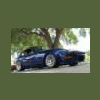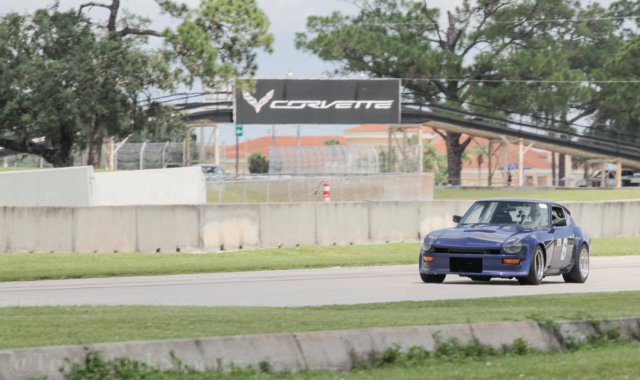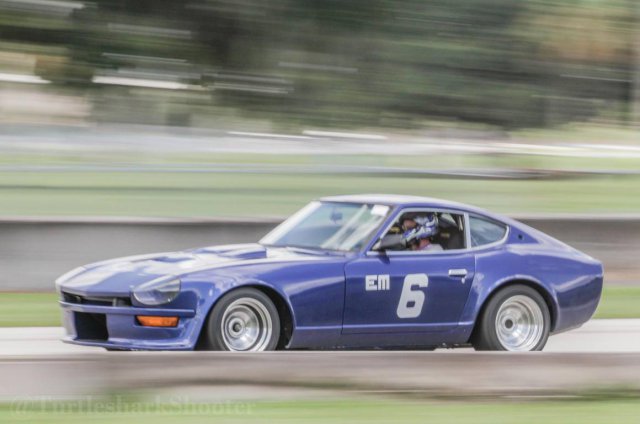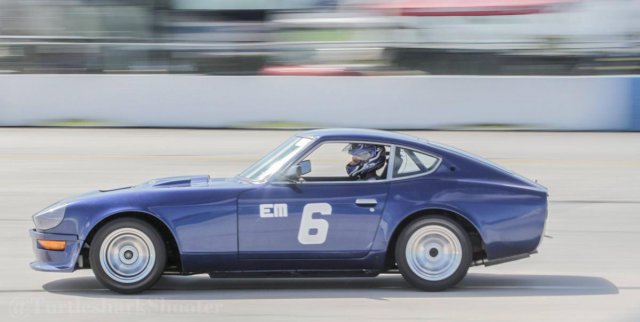-
Posts
1161 -
Joined
-
Last visited
-
Days Won
10
Content Type
Profiles
Forums
Blogs
Events
Gallery
Downloads
Store
Everything posted by 74_5.0L_Z
-

Fuel starvation after heavy cornering on track
74_5.0L_Z replied to turbogrill's topic in S130 Series - 280ZX
I swear by the ATL Black Box fuel sump. It is a gated plastic box that sits inside your fuel cell. The fuel pump is inside the box and is plumbed out through the top of the cell. Gates allow fuel into the box from three sides. I also plumb my fuel return into the top of the box. The system is so effective that l have completed a track session without any starvation issues and then have the car run out of fuel loading it onto the trailer. Good to the last drop. -
What do you want to do with the car? Are you auto-crossing, drag racing, or just driving? How are the roads where this car will be driven? Is the car structurally sound or is it really rusty? Does it have a cage or any structural reinforcement? Are you planning to run camber plates or use the stock isolators? My car has a lot of structural reinforcement. I autocross and road race. My front springs are 500 lb/in and are 8 inches tall free length. My rear springs are 400 lb/in and again 8 inch free length. You have to consider rate and free length when selecting springs and while you are placing the coil-over sleeve on the strut.
-
If you lower the S30 and do not significantly increase the spring rate then you will most likely experience bottoming of the suspension over bumps. On a lowered Z, the benefits of coil-overs come mostly from the availability of different lengths and rates of springs, and from the additional clearance between the strut and wheel. Read the sticky regarding sectioning struts. To properly lower a Z car the struts must be sectioned, you must install shorter inserts, and you must have decent bump stops.
-

Arizona Z Car brakes are awesome
74_5.0L_Z replied to crapforum's topic in Brakes, Wheels, Suspension and Chassis
You cannot use the full potential of bigger front brakes until you have also added appropriately sized rear brakes. A balanced set-up is key to maximum braking performance. Right now, with the upgraded front and stock rear, the front brakes will lock easily and the rear are doing not much of anything. I found myself in the same predicament years ago when I upgraded the front brakes before the rear. The brakes felt better than stock but were severely limited by the stock rears. I finally decided that upgrading the rears to match the front was mandatory after trying to stop on a wet slippery bridge. The front locked super easy and the rear did nothing. I nearly hit the car in front of me before getting stopped. An unbalanced brake set-up is dangerous to drive in wet conditions. If you have four 1.75 " pistons (per caliper) in the front, then you will need four 1.375 pistons (per caliper) in the rear and a proportioning valve in the rear brake circuit to get good brake balance. -

Sway bar for my Laurel C31
74_5.0L_Z replied to JelmerPatrol's topic in Brakes, Wheels, Suspension and Chassis
The center to center distance for the mounting bushings on the S30 is 700 mm, so the S30 sway bars are likely too narrow for your application. I would look into a sway bar for an older Mustang. I used to play with the older Mustangs (69-70). They had a similar shape and were wider than the S30 sway bars. -

Roll bar question ...
74_5.0L_Z replied to VitaminZ's topic in Brakes, Wheels, Suspension and Chassis
I think that piece of metal might be sufficiently strong for hanging up your laundry after it comes out of the washing machine. Other than that, I see no useful purpose. -
I have run three track days now with the MSA flush mount mirrors. They don't move and the visibility is great.
-

Brake trouble shooting with pressure gauge
74_5.0L_Z replied to RebekahsZ's topic in Brakes, Wheels, Suspension and Chassis
Here is a little light reading regarding caster, its measurement, and its effects. http://www.disco3.co.uk/gallery/albums/userpics/24543/steering-geometry-and-caster-measurement%5B1%5D.pdf -

LS/T56/240z Project Mentor Wanted
74_5.0L_Z replied to RebekahsZ's topic in S30 Series - 240z, 260z, 280z
Caster does have a jacking effect, but only when the steering wheel is turned. When corner balancing the car, you REALLY need to make sure the wheels are pointing straight ahead. If you have 6+ degrees of caster, then turning the wheel will significantly affect the scale readings. If you turn left, the left front wheel and right rear wheel will gain load and the right front and left rear will lose load. On a related note, caster (or more specifically caster trail) produces a torque about the steering axis. If both wheels have equal caster, then when you are driving straight the caster induced torques at the front wheels will be equal but opposite therefore cancelling each other out. If one of the front wheels has significantly more caster than the other, then the car will pull toward the side that has less caster. -

Brake trouble shooting with pressure gauge
74_5.0L_Z replied to RebekahsZ's topic in Brakes, Wheels, Suspension and Chassis
I'm guessing that your caster is not equal left to right. -

New project-reducing bumpsteer
74_5.0L_Z replied to RebekahsZ's topic in Brakes, Wheels, Suspension and Chassis
Do you have stock control arms? How much caster? Bump steer spacers? Camber plates? The stock camber curve at stock ride height starts off toeing out with bump and then at extreme bump start to toe in. When you lower the car with everything else stock, you operate closer to the hump where the curve transitions from toe out to to in on bump. The bump steer spacers help get a lowered car back in the safe toe out on bump region of the curve. From the pictures, you have lowered the front substantially. Bump steer spacers will help but probably not enough. Raising the LCA pickup helps the camber curve on a lowered Z, but also moves you more toward the toe in region of the curve. Your options are as follows: 1. Raise the car so that you are operating in the toe out region in bump. 2. Raise the steering rack relative to the LCA pickup points. 3. Lower the outer tie rod ends to get back in the toe out range. In all of the above, you are just moving around on the same curve. To change the curve, you need to use a different length rack. I wish you were close enough for me to come help you out. Good luck. -
If you are good at math, try "A Multi-body Systems Approach to Vehicle Dynamics "https://books.google.com/books?id=FlBgF8w9CegC&source=gbs_similarbooks
-

ST front sway bar clearance question
74_5.0L_Z replied to madkaw's topic in Brakes, Wheels, Suspension and Chassis
Let's see a picture of the end links. The simple cure is to replace the six with a V8. Problem solved. Actually, I had a similar issue wth an ST sway bar years ago when I still had the L6. For me, the cure was longer end links. -
Delete the rear sway bar.
-

shops that do turnkey ls 240z swap?
74_5.0L_Z replied to alphalonewolfxiong's topic in Gen III & IV Chevy V8Z Tech Board
I think Hoke Performance does this. He's in Asheville NC. -
Thieves should die of lead poisoning.
-

Off centered 75 280z steering rack....hmm
74_5.0L_Z replied to marinez's topic in Brakes, Wheels, Suspension and Chassis
Replace the crossmember and get the suspension geometry correct. If the steering shaft hits the exhaust, modify the steering shaft. The addition of an extra u-joint and constraint is well documented on this site. If you just modify the tie rods, you will have bump steer issues. The car will toe in on bump on one side and toe out in bump on the other side. Every time you hit a bump with both front tires, the car will try to turn. Take the time and fix it right. I have a stock front crossmember that you can have for the cost of shipping. -
Packaging drove the primary lengths for my exhaust. My primaries vary from 25 to 27 inches (measured from the exhaust flange to the beginning of the merge collectors). Being as short as they are, I expected to lose some bottom end torque. Unexpectedly, I gained 38 lb-ft of torque.
-
Cool! That is exactly how defined the bends for my exhaust. Except, I made everything from j-bends. Who did you use to do the CNC bending? How much did they charge. That looks really good. How long are the primary tubes?
-

Off centered 75 280z steering rack....hmm
74_5.0L_Z replied to marinez's topic in Brakes, Wheels, Suspension and Chassis
I would start by getting an unmolested crossmember and see if it will bolt up. If not, you may need to visit a frame shop. -

Off centered 75 280z steering rack....hmm
74_5.0L_Z replied to marinez's topic in Brakes, Wheels, Suspension and Chassis
Pictures would make this whole conversation meaningful and allow us to be helpful. -

Off centered 75 280z steering rack....hmm
74_5.0L_Z replied to marinez's topic in Brakes, Wheels, Suspension and Chassis
First, jack up the car and support on jack stands. Remove clamps from the boots on rack. Pull boots off rack housing and slide the boots outward to expose rack shaft on both sides of housing. Next, center the rack so that the same amount of rack shaft is exposed on both sides (2.39 inches measured between the housing and inner tie rod body to be precise). The rack in now centered. If the steering wheel is not centered, then remove and reinstall in correct orientation. Adjust toe with rack in centered position described above. I have spacers that I place over the rack shaft to keep it centered during to alignment. I make absolutely sure that the rack is centered. -

inner tie rod question
74_5.0L_Z replied to zombie-nsk's topic in Brakes, Wheels, Suspension and Chassis
Please state your problem clearly and provide a little context. Otherwise no one will be able to help. Did it start acting up spontaneously? Did it start happening after a suspension modification or repair? Can you provide pictures to aid in the explanation? -

Lowering the steering rack
74_5.0L_Z replied to grannyknot's topic in Brakes, Wheels, Suspension and Chassis
Can you get the balancer behind the rack? Unfortunately, the way to improve the bump steer on an S30 is to raise the rack or lower the outer tie rod. At the stock rack height, the front suspension has a bit of toe out on bump (~0.5 deg per inch of bump). A small amount of toe out on bump for the front suspension is safe and here is why: You are driving down the road and hit a bump with one front wheel. The suspension on the one front wheel compresses and the bumped front wheel steers outward. This causes the car to slightly steer toward the bumped wheel and lean away from the bumped wheel which causes the bumped wheel to return toward it original position and the opposite wheel's suspension to compress. The overall effect is that the suspension wants to get back to its original steady state configuration. If you lower the rack 1.75 inches , the front suspension will toe in severely in bump (more than 1 degree per inch of bump). This will make the car dangerous to drive. This is dangerous because the bumped wheel will steer the car away from the bump which will cause the suspension to compress further which will make the car steer even more inward. At low speeds, you may be able to compensate with steering. However, at high speeds you will reach a point where you cannot compensate. This is called the critical speed. If you can't get the engine behind the rack, move the rack forward. If you move the whole crossmember, then you will add caster and give yourself some clearance. If you still need more room then move the rack forward independent of the crossmember. You will lose a bit of Ackermann, but you can live with that. You might not live with severe toe in during bump in the front suspension. And bump steer spacers will not help this situation at all. -

Camber change after 1.5" drop?
74_5.0L_Z replied to mtnickel's topic in Brakes, Wheels, Suspension and Chassis
If you run EMOD then rules are not a problem. Any suspension, any brakes, any engine just as long as you are not less than 1750 lbs.




